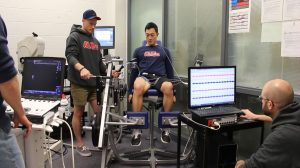
UM doctoral students (from left) Sam Buckner, of Fort Lauderdale, Florida; Kevin Mattox, of Pittsburgh; and J. Grantmouser, of Norman, Oklahoma, demonstrate blood flow restriction technique used in the Kevser Ermin Applied Physiology Laboratory. UM photo by Sarah Sapp
OXFORD, Miss. – Research being conducted at the University of Mississippi on blood flow restriction therapy is drawing international attention for its clinical and sports performance applications.
Under the leadership of Jeremy P. Loenneke, assistant professor of health, exercise science and recreation management, the Kevser Ermin Applied Physiology Laboratory is quickly gaining renown for breakthroughs in low-load alternatives to traditional resistance exercise.
This therapy helps rebuild muscle using less weight and less intensity by slightly inflating a pressure cuff that is attached to a person’s limbs for a few minutes to restrict blood flow.
“This allows a muscle to work harder than it normally would so a person can gain the same benefits of normal exercise without having to physically lift heavy weights,” Loenneke said.
“Typically when people exercise, they have to train pretty heavy to see any type of benefit. For most people that’s OK, but people who have had surgery or who are older may not have the ability to do that. Our current work focuses a lot of the methodology and the safety of applying blood flow restriction therapy, which is something many clinicians are wanting to know more about.”
Loenneke was in Denmark over the weekend, speaking at a symposium and leading a workshop on blood flow restriction therapy at the Danish Association of Physiotherapy Congress meeting in Odense. This is Loenneke’s second time to hold a workshop there on this subject.
The researcher first came across blood flow restriction when he was interning at the University of Illinois in 2007. He began completing his own work on the subject in 2008 while at Southeast Missouri State University and later while earning his doctorate at the University of Oklahoma.
When he first read of this therapy in literature, he was surprised by the broad application of its benefits.
“My first thought when I came across this literature as an undergraduate was that I must be reading this wrong,” Loenneke said.
While studying at Oklahoma, he was contacted by a physical therapist at the Center for the Intrepid, a rehabilitation center for wounded soldiers. Loenneke said he helped explain how to best apply blood flow restriction for rehabbing soldiers with blast trauma.
“The problem is that a lot of these injuries cannot be trained with normal exercise intensities,” Loenneke said. “Blood flow restriction is a potential utility that clinicians are using a lot in clinical trials or hospital settings.”
At Ole Miss, Loenneke has six doctoral students working alongside him, as well as Takashi Abe, a visiting professor and longtime friend.
“We are lucky here at Ole Miss, because Dr. Abe has been studying blood flow therapy for a long time,” Loenneke said. “I first began reading his literature in 2007, and now he works with our group. We are one of the groups that is more known for blood flow restriction literature in the United States.”
At the Danish symposium, Loenneke focused on blood flow restriction exercise after surgery or disease. Clinicians are interested in focusing on immediate post-surgery recovery because there is a short window of time after surgery for a person to regain muscle strength, he said.
As an academic, Loenneke’s role at the meeting is to educate clinicians on how this therapy works within a laboratory setting so they can use their best judgments in considering the use of this therapy and making the proper adjustments to apply it to post-surgery patients.
To gather data at UM, Loenneke and his team study the effects of blood flow therapy on healthy people, ages 18-35, by applying the cuff and measuring what happens in different situations.
“Sometimes we study the effects of this therapy with no exercise at all, and sometimes we do it with exercise and training,” he said. “We get the data, write it up and publish it. Our work is primarily published within sports medicine-related journals.”
Blood flow restriction therapy benefits normal, healthy people in many ways, Loenneke said. While researching the methods, the team wanted to create a practical model using equipment that most lifters already have or could easily get, he said.
He has seen Ole Miss students using blood flow restriction therapy.

Blood flow restriction therapy works by slightly inflating a pressure cuff attached to a person’s limbs for a few minutes to restrict blood flow during exercise. UM photo by Sarah Sapp
“I’ve seen people doing it upstairs in the Turner Center,” Loenneke said. “I don’t think they know that a lot of the work put in creating those methods was actually done by people who are now here. It’s a really cool thing to see.”
Minsoo Kang, chair of the Department of Health, Exercise Science and Recreation Management, expressed his excitement for the lab’s research to be seen on an international stage.
“Dr. Loenneke and his research students have earned national attention for their work with blood flow restriction exercise over the past three years,” Kang said. “It is quite significant of him presenting at an international stage, which I believe will increase the visibility of our department, school and university.”
For more information about the UM Department of Health, Exercise Science and Recreation Management, visit http://hesrm.olemiss.edu/.
